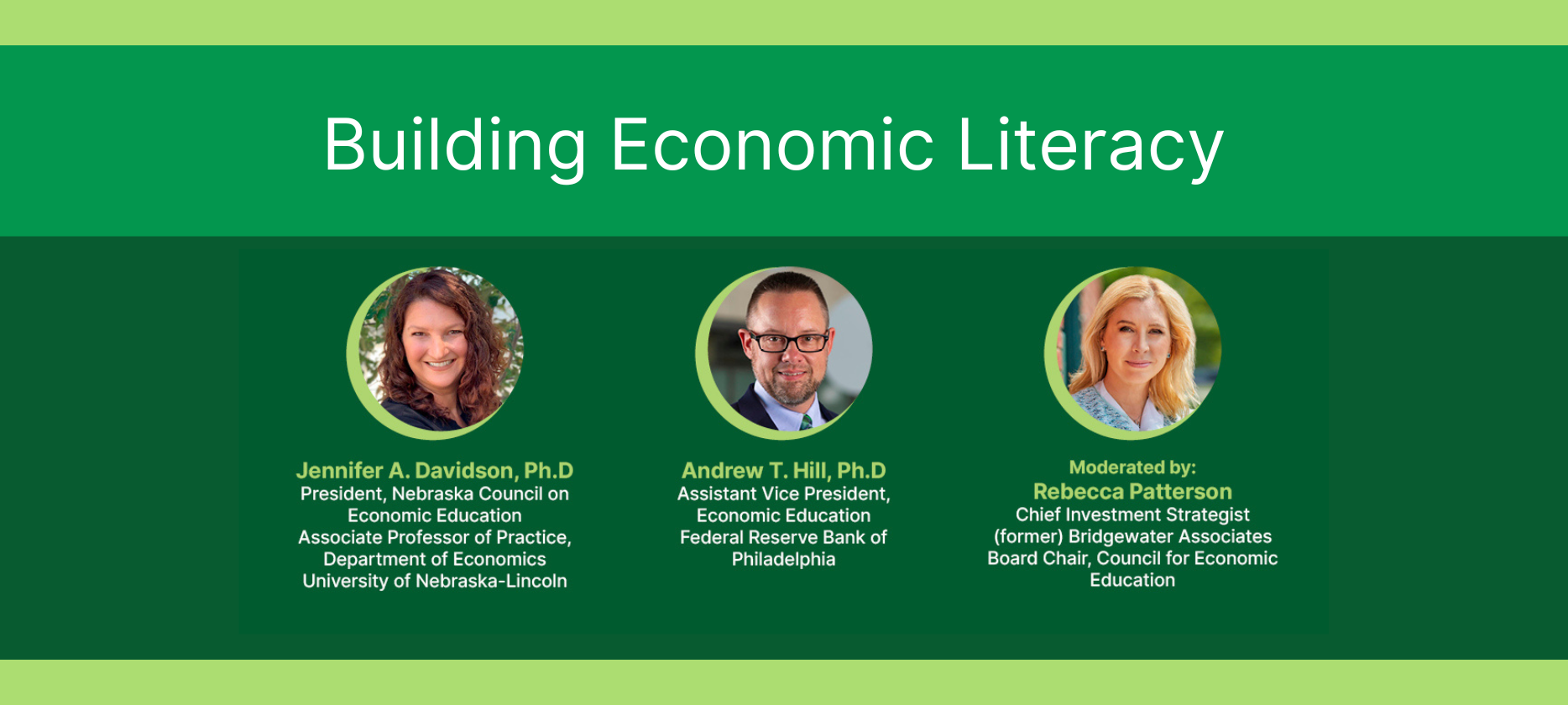
Inspiring the Next Generation: Insights from the CEE Webinar on Building Economic Literacy
In a recent webinar hosted by the Council on Economic Education (CEE), experts gathered to discuss the state of economic education in the United States. The conversation featured Dr. Jennifer Davidson, President of the Nebraska Council on Economic Education, and Dr. Andrew Hill, Assistant Vice President of Economic Education at the Federal Reserve Bank of Philadelphia. The session was moderated by Rebecca Patterson, Former Chief Investment Strategist at Bridgewater and Board Chair of CEE.
The Importance of Economic Education
The webinar began with a discussion on the critical role of economic education in shaping the financial futures of young people. Dr. Davidson emphasized that economics is fundamentally about decision-making and understanding scarcity. She explained, “Economics, at its core, is all about decision making. It’s about the fact that scarcity exists. We can’t have everything we want and we have to make choices”. This knowledge and the tools to analyze and make decisions smartly is essential for students to navigate their personal and professional lives effectively.
Dr. Hill highlighted the Federal Reserve’s long-standing commitment to economic education, which dates back to the 1970s. He noted that understanding how the economy works, and the role of the Federal Reserve can help individuals make better decisions, ultimately leading to a more stable and prosperous economy.
The State of Economic and Personal Finance Education
Ms. Patterson provided an overview of the current landscape of economic and personal finance education in the U.S. She shared that 28 states require at least one course in economics to graduate, and 35 states require at least one course in personal finance. Despite this progress, there is still much work to be done to ensure that all students actually receive this essential education and when they do, that it is from a teacher who is qualified and trained in the subject.
Dr. Davidson and Dr. Hill discussed the challenges of implementing these requirements at the state level. They noted that education standards are often reevaluated every 5 to 10 years, and the process can be slow and complex. However, they stressed the importance of continued advocacy and collaboration to expand access to economic and personal finance education.
The Multiplier Effect of Teaching Teachers
One of the key themes of the webinar was the multiplier effect of teaching teachers. Dr. Hill explained “If you work with a teacher and you spend hours or a day training a teacher, those teachers are then, for the rest of their career going to share those lessons and experiences with their own students for many years to come” This approach ensures a high return on investment and helps reach a larger number of students.
Dr. Davidson shared her experience in Nebraska, where teachers are now required to take more credit hours in economics as part of their certification. She emphasized the importance of providing ongoing professional development for teachers to keep them engaged and effective in the classroom.
Collaboration and Innovation in Economic Education
The webinar also highlighted the importance of collaboration among various organizations involved in economic education. Dr. Hill mentioned the long-standing partnership between the Federal Reserve and CEE, which has resulted in numerous successful programs and initiatives. Dr. Davidson added that state councils and centers for economic education play a crucial role in supporting teachers and students at the local level.
Ms. Patterson shared examples of innovative programs, such as the National Economics Challenge and the National Personal Finance Challenge, which engage students in competitive and interactive learning experiences. These programs not only enhance students’ understanding of economics and personal finance but also provide valuable skills for their future careers.
Ms. Patterson also emphasized the broader impact of economic education, stating, “Ensuring that students have a foundational understanding of economics is a critical building block for them to have healthy financial lives. And it doesn’t stop just at those individuals who are reached, but also their families, their communities. And when we think about that in aggregate, that’s how we get a stronger economy and a more stable financial system”
Conclusion
The CEE webinar underscored the vital importance of economic education in preparing young people for their futures. By continuing to advocate for these subjects, supporting teachers, and fostering collaboration, we can ensure that all students have the knowledge and skills they need to make informed financial decisions. As Dr. Davidson aptly put it, “Economics is a superpower for understanding the world around you”
Updated National K-12 Economics Standards are coming this June!
The Voluntary National Content Standards offer economics content standards. Each standard is an essential principle of economics that an economically literate student should know and a statement of what the student should be able to do with that knowledge at grades 4, 8, and upon graduating from high school.
Sign up to receive your copy this summer:
A Few Statistics on Economic Education
- Taking more economics is significantly related to higher levels of earning, home equity, and savings.
- Research indicates that 6 in 10 teachers earned no course credits in economics during their undergraduate studies. Of teachers certified to teach social studies, 40% did not take an undergraduate course in economics.
Watch the Event Recording
About the Council for Economic Education
The Council for Economic Education’s (CEE’s) mission is to equip K–12 students with the tools and knowledge of personal finance and economics so that they can make better decisions for themselves, their families, and their communities, and learn to successfully navigate in our ever-changing economy. We carry out our mission in three ways. We advocate to require financial and economic education in every state. We provide training, tools and resources – online and live through over 180 affiliates nationwide – to more than 40,000 teachers annually who in turn bring the highest quality economics and personal finance instruction to over 4 million students. We deepen knowledge and introduce high school students to critical career capabilities through our national competitions and Invest in Girls program.
Media contact:
Read More

CEE’s National Economics Challenge is Going Global!
The Council for Economic Education (CEE) is excited to announce the expansion of our National Economics Challenge (NEC) internationally as part of the World Youth Forum-Future Economics…

National Economics Challenge Winners 2024
Think fast! What are two actions that the Federal Reserve might take to combat inflation? If the average cost of producing four cars is $20,000 and the average cost of…

National Personal Finance Challenge Winners 2024
Capping a school year of tremendous strides in requiring personal finance classes in America’s high schools, 35 teams gathered in Cleveland at the Council for Economic Education’s annual …